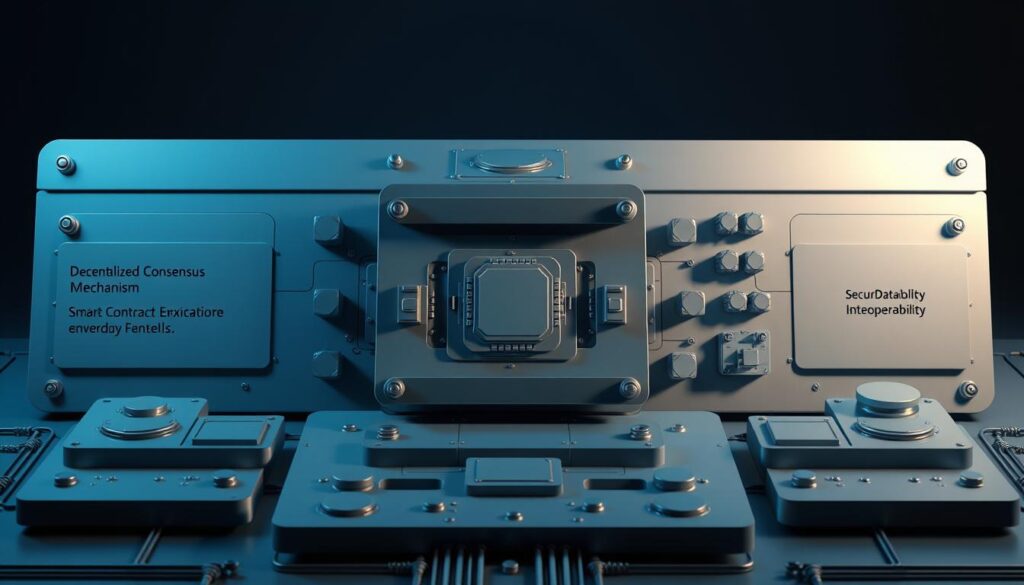Now Reading: How to Leverage Modular Blockchain Platforms for Your Business
- 01
How to Leverage Modular Blockchain Platforms for Your Business
How to Leverage Modular Blockchain Platforms for Your Business

Traditional systems often struggle to balance speed, security, and flexibility. A new approach is reshaping how enterprises interact with distributed networks by splitting core functions into specialized layers. This method allows businesses to customize their tech stack while maintaining robust security standards.
Imagine building with LEGO blocks instead of carving from stone. By separating execution, settlement, and consensus layers, companies gain unprecedented control over their digital infrastructure. This shift enables 100x faster processing for specific tasks compared to older models. Customization becomes practical, costs drop, and cross-chain collaboration simplifies through blockchain interoperability solutions.
Adopting this architecture isn’t just about technical upgrades. It’s a strategic move to future-proof operations. Enterprises can scale efficiently without compromising decentralization. Teams mix and match components to create tailored solutions, whether for supply chain tracking or decentralized finance applications.
Key Takeaways
- Specialized layers enable targeted performance upgrades without system-wide overhauls
- Cost reduction comes from optimizing specific network components
- Customizable architectures support diverse industry requirements
- Security remains intact through decentralized validation processes
- Cross-chain compatibility unlocks new partnership opportunities
Introduction to Modular Blockchain Platforms
Breaking free from rigid one-size-fits-all solutions, modular blockchain architectures let businesses customize their infrastructure through specialized layers. Unlike traditional setups that combine multiple roles, this approach assigns distinct tasks to separate components. The result? Enhanced performance and flexibility tailored to specific needs.
Think of it like a professional kitchen. Each chef masters one station—grilling, sautéing, or baking—to optimize meal quality and speed. Similarly, blockchain systems divide core functions into four elements:
- Execution: Processes transactions and smart contracts
- Consensus: Validates network-wide agreement
- Data availability: Ensures transparent access to transaction history
- Settlement: Finalizes and secures completed actions
By isolating these layers, companies can upgrade individual parts without disrupting the entire operation. This targeted optimization reduces costs and boosts efficiency. For example, a retail chain might prioritize fast transaction processing while a healthcare provider focuses on data security.
Understanding these concepts helps businesses evaluate blockchain solutions for modern distributed networks. The right combination of components creates adaptable frameworks ready for future design challenges.
Understanding the Blockchain Scalability Trilemma
Digital networks face a critical balancing act between three competing priorities. Known as the scalability trilemma, this challenge forces systems to prioritize two attributes while compromising on the third. Let’s unpack why achieving harmony between these elements remains elusive—and how modern solutions are evolving.

Security Versus Decentralization Trade-offs
Security forms the backbone of any reliable network. It ensures protection against attacks and unauthorized changes. However, strengthening defenses often requires specialized hardware or complex protocols, which can exclude smaller participants.
Decentralization demands low barriers to entry. When verification processes become too resource-heavy, only large entities can afford to run nodes. Bitcoin’s approach illustrates this tension—its proof-of-work mechanism prioritizes security and decentralization but limits transaction speed.
Scalability Challenges and Solutions
Throughput bottlenecks emerge when networks handle more transactions per second. Simply enlarging blocks might seem like a fix, but it increases storage demands—pushing smaller nodes out of the system. Solana’s high-speed model demonstrates alternative trade-offs, optimizing for speed at the cost of broader participation.
New architectures address these limitations through layered designs. By separating core functions, systems can scale efficiently without sacrificing security or open participation. This method allows targeted upgrades where they matter most, like optimizing data verification processes independently from transaction execution.
Evolution from Monolithic to Modular Blockchain Systems
The digital ledger landscape transformed dramatically as early networks hit performance ceilings. Pioneering chains like Bitcoin and Ethereum revolutionized finance but faced growing pains as adoption exploded. Their single-layer approach—handling every function from execution to consensus—created bottlenecks that sparked architectural innovation.
Historical Perspectives and Milestones
First-generation systems set critical precedents despite limitations. Ethereum’s smart contract capabilities enabled programmable money, while Bitcoin proved decentralized value transfer. Yet both struggled with:
- Network congestion during peak usage
- High transaction fees
- Limited customization options
Dr. Gavin Wood, Ethereum’s co-founder, foresaw these challenges. His work on Polkadot introduced modular concepts years before mainstream adoption. This evolution marked a turning point—from viewing chains as indivisible units to customizable systems.
Emerging Innovations in Blockchain Architecture
Layer 2 solutions initially addressed throughput issues. Optimistic rollups and sidechains provided temporary relief but didn’t resolve structural trade-offs. The breakthrough came through reimagining blockchain architecture itself:
Polkadot’s parachain model demonstrated native modular design, while Ethereum embraced sharding. Modern frameworks now enable:
- Specialized chains for distinct functions
- Custom consensus mechanisms
- Adaptable data privacy configurations
This shift from rigid monolithic blockchain structures to flexible components mirrors how industries adopt specialized tools. Enterprises no longer need compromise between speed, security, or scalability—they assemble solutions tailored to specific operational needs.
Core Components of a Modular Blockchain Architecture
Modern distributed systems achieve flexibility through specialized layers that handle distinct tasks. This approach separates critical functions to optimize performance while maintaining security standards. Let’s explore the four pillars powering this design.

Execution and Smart Contracts
The execution layer acts as the user’s gateway. Here, transactions get processed and smart contracts activate predefined actions. Imagine swiping a credit card—this layer handles the immediate action while other components verify and record it.
Consensus, Data Availability, and Settlement Layers
Three interconnected systems ensure reliability:
- Consensus: Full nodes validate transactions through agreed-upon rules
- Data availability: Publishes transaction history for independent verification
- Settlement: Acts as final arbitrator for disputed actions
These layers work like airport security checkpoints. Each specializes in one task—baggage screening, identity checks, or final boarding approval—to maintain efficiency without compromising safety. By isolating functions, systems achieve faster processing while keeping validation decentralized.
Deep Dive: modular blockchain platforms for Business
Modern enterprises demand flexible solutions to address diverse operational needs. These adaptable systems allow companies to mix specialized components like puzzle pieces, creating tailored infrastructures for specific industries. Financial institutions optimize transaction speeds, while healthcare providers prioritize data encryption—all within the same framework.
Enterprise Benefits and Strategic Advantages
Customizable architectures slash development time by 40-60% compared to traditional setups. Teams reuse verified components instead of building from scratch, accelerating deployment for applications like supply chain tracking or digital identity verification. This agility helps businesses pivot quickly as market demands shift.
Fractal scaling through layer 3 solutions unlocks new possibilities. Developers deploy application-specific rollups with full infrastructure control while maintaining cross-chain compatibility. A gaming studio could launch a dedicated transaction layer without overhauling its entire network.
Real-world implementations show measurable results:
- Global banks reduced settlement times from days to minutes
- Retailers cut counterfeit incidents by 92% using transparent ledgers
- Energy firms automated carbon credit trading through smart contracts
These systems also simplify compliance. Companies select audit-ready components for regulated industries while maintaining interoperability with partners. The result? Faster innovation cycles and stronger competitive positioning across sectors.
Harnessing the Power of Rollups and Smart Contracts
Businesses seeking faster transaction speeds now turn to specialized scaling solutions. Rollups handle thousands of operations off-chain while anchoring security to parent networks. This approach maintains decentralization while boosting throughput—critical for applications like payment systems or NFT marketplaces.

Optimistic Rollups Explained
Optimistic rollups work like trusted accountants. They assume transactions are valid unless challenged. Special sequencers process data off-chain, reducing the load on the main network. Results get posted to the base layer with a 7-day window for fraud proofs.
This system achieves 10-100x speed gains compared to traditional execution methods. Validators stake crypto as collateral, creating economic incentives for honest behavior. Projects like Arbitrum use this model to support complex smart contracts without congestion.
An Overview of Zero-Knowledge Rollups
Zero-knowledge rollups take a different path. Every batch of transactions requires cryptographic proof—mathematical verification that computations are correct. ZK-SNARKs and STARKs enable instant finality, eliminating waiting periods.
While more resource-intensive, this method offers stronger security guarantees. Chains like zkSync leverage these proofs for privacy-focused applications. The trade-off? Higher development costs versus near-instant settlement times.
Interoperability and Cross-Chain Functionality in Modular Designs
Digital ecosystems thrive when different systems communicate effortlessly. Modern architectures achieve this through standardized connectors that let chains exchange data and assets like puzzle pieces snapping together. This eliminates fragmented workflows while preserving each network’s unique rules.
Plug-and-Play Components in Modern Blockchains
Polkadot demonstrates this principle through its XCM messaging system. Rollups transfer assets across specialized layers without third-party bridges. A gaming app could move tokens between chains as smoothly as sending email attachments.
Celestia’s flexible design takes interoperability further. Its data availability layer supports multiple execution environments, creating secure bridges between ecosystems. Developers mix components like building blocks—swap consensus mechanisms without rewriting entire systems.
Three key advantages emerge:
- Reduced hacking risks compared to external bridge solutions
- Shared infrastructure cuts development costs by 30-50%
- Independent chains collaborate like departments in a corporation
Businesses leverage these features for multi-chain applications. A logistics firm might track shipments on one network while processing payments on another—all through a unified interface. This flexibility future-proofs tech investments as industry needs evolve.
Comparing Modular and Monolithic Blockchain Architectures
Choosing the right digital infrastructure requires understanding core design philosophies. Two distinct models dominate today’s landscape—each with unique strengths and trade-offs.
Balancing Flexibility With Stability
Monolithic architectures like Solana excel at raw speed. Their unified structure processes thousands of transactions per second using high-powered nodes. This approach prioritizes scalability but risks centralization as hardware demands rise.
Modular systems take a different path. Ethereum’s layered design allows specialized components for tasks like smart contracts or data verification. While this flexibility suits DeFi and gaming apps, coordinating multiple layers adds complexity during upgrades.
Security profiles differ sharply. Monolithic chains deter attacks through proven, battle-tested code. Modular setups reduce single points of failure but require rigorous testing across interconnected parts. Developers face tough choices—speed versus adaptability, simplicity versus customization.
Ethereum’s evolution shows modular potential despite challenges. Its thriving ecosystem proves fragmented architectures can foster innovation when balanced with reliable core systems. Businesses must weigh these factors against their operational priorities and growth timelines.
FAQ
How do modular systems address the blockchain scalability trilemma?
By separating core functions like execution, consensus, and data storage into specialized layers, these systems optimize each component independently. This design allows better balance between security, decentralization, and throughput without compromising any single pillar.
What distinguishes modular architectures from monolithic chains?
Monolithic chains handle all operations—smart contracts, transaction validation, and data storage—on a single layer. Modular designs decouple these tasks, enabling customizable solutions. For example, Ethereum leverages rollups for execution while relying on its base layer for settlement.
Why are rollups critical for modern blockchain ecosystems?
Rollups process transactions off-chain and submit proofs to the main network, drastically improving speed and reducing costs. Optimistic variants assume validity unless challenged, while zero-knowledge (ZK) types use cryptographic proofs, enhancing privacy and finality.
How does data availability impact decentralized networks?
Ensuring participants can independently verify transaction data is vital for trustlessness. Dedicated layers like Celestia or EigenDA focus solely on this function, preventing bottlenecks and enabling lightweight nodes to participate securely.
Can enterprises benefit from adopting modular solutions?
Yes. Businesses gain flexibility to tailor components like privacy-focused execution layers or high-throughput consensus mechanisms. This adaptability supports use cases ranging from supply chain tracking to real-time financial settlements.
What role does interoperability play in multi-chain environments?
Modular designs simplify cross-chain communication through standardized interfaces. Projects like Polkadot and Cosmos exemplify this approach, allowing assets and data to move seamlessly between specialized chains while maintaining security.














